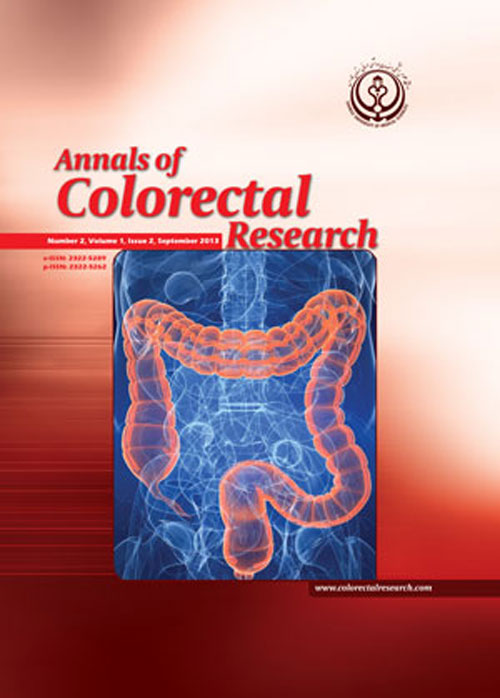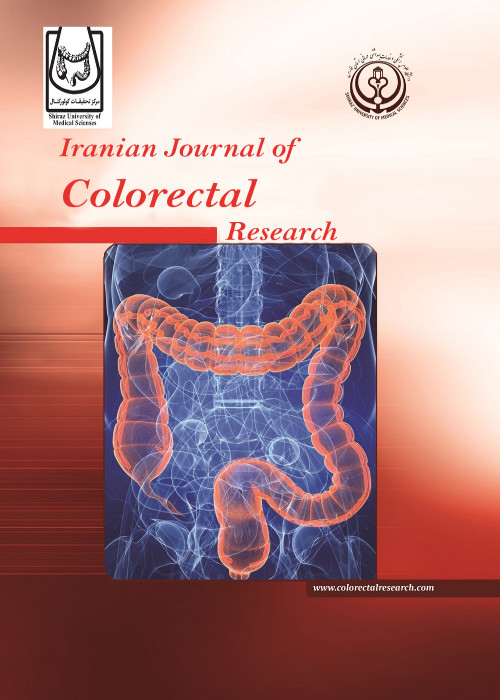فهرست مطالب

Iranian Journal of Colorectal Research
Volume:4 Issue: 1, Mar 2016
- تاریخ انتشار: 1395/02/20
- تعداد عناوین: 8
-
-
Page 1Context: The term inflammatory bowel disease (IBD) classically includes ulcerative colitis (UC) and Crohns disease (CD). An abnormally increased mucosal permeability seems to underlie UC, whereas CD is thought to be the result of an immune deficiency state..
Evidence Acquisition: While these phenomena may well be labeled as genetic factors, the environment has its role as well. Drugs (chiefly, antibiotics and non-steroidal anti-inflammatory molecules, with proton pump inhibitors recently joining the list) and smoking habits are all being scrutinized as IBD causative factors..ResultsOnce almost unknown, the prevalence of IBD, in the Eastern World and China, is now increasing by manifold, therefore arousing warning signals..ConclusionsA multidisciplinary approach will soon be necessary, to face the tenacious behavior of IBD, on a global perspective..Keywords: Inflammatory Bowel Disease, Physiopathology, Microbiome, Epidemiology, Genetics -
Page 2BackgroundWeb-based learning is increasingly used as an adjunct to, and a replacement for, traditional learning methods. We investigated the impact of web-based learning modules in improving the delivery of undergraduate medical education in general surgery and urology.ObjectivesTo determine if online learning modules improve student performance in general surgery and urology. To determine if previous use of online learning modules promote future utilization of such modules among students.Materials And MethodsFour general surgical and urologic web-based learning modules were delivered as an adjunct to traditional teaching via an online learning management system to fourth year medical students in 2009 and 2010. Each module contained 40 identical pre-module and post-module questions which allow analysis of change in student performance after delivery of these modules. The student t-test and Fishers exact test were used for statistical analysis.ResultsIn urology, the mean pre-module score was 22.4 (SD 4.3) and the mean post-module score was 33.0 (SD 2.1) (PConclusionsThe introduction of web-based general surgery and urologic learning modules as an adjunct to traditional teaching improved student knowledge, and their usage improved over time.Keywords: Education, General Surgery, Online Systems, Urology
-
Clinical and Pathological Characteristics of Mucinous Colorectal Adenocarcinoma: A Comparative StudyPage 3BackgroundMucinous adenocarcinoma accounts for approximately 5% - 15% of all colorectal cancers.ObjectivesThe aim of this study was to investigate the clinicopathological characteristics of patients with mucinous colorectal adenocarcinoma.
Patients andMethodsThis retrospective study was carried out by reviewing the medical records of 70 mucinous colorectal cancer (MCC) patients who were diagnosed and treated at a tertiary academic hospital between 2005 and 2010. For the comparative analysis, 491 patients with non-mucinous colorectal cancer (NMCC) were included.ResultsOf 561 patients with colorectal adenocarcinoma, 70 patients (12.5%) had the mucinous type. There were 42 (60%) men and 28 (40%) women, with a median age of 55 years old (range 24 - 81 years) included in the study. We did not find any differences regarding the patients mean age (P = 0.408) and male/female ratio (P = 0.700) between the MCC and NMCC; however, there was a predilection for the right colon and sigmoid colon in the MCC, when compared to the NMCC (P = 0.012). In addition, the MCC tended to have a larger tumor size (P = 0.004), higher histological grade (PConclusionsThis study indicates that most clinicopathological characteristics of MCC are different from those of NMCC. In addition, there was an association between the mucinous subtype and adverse pathological features in the patients with colorectal cancer.Keywords: Colorectal Cancer, Mucinous Adenocarcinoma, Pathology, Characteristics -
Page 4BackgroundThe epidemiology of inflammatory bowel disease (IBD) is changing globally and there is disagreement between studies about the prevalence of relapse of ulcerative colitis (UC) as a type of IBD..ObjectivesThe current study aimed to find out the incidence of relapses in patients with UC in Southern Iran..
Patients andMethodsIn a prospective cohort study in a period of one year (from October 2012 to October 2013) 157 patients with UC who were in clinical remission for at least three months and were registered in the IBD registry of Shiraz University of Medical Sciences, Shiraz, Iran were enrolled. The sample size was calculated according to the formula to determine a ratio. Clinical relapse was described as deterioration of bowel movements, lower intestinal bleeding or worsening of abdominal pain and diarrhea leading to changes in previous treatment. Age and gender distribution and the frequency of relapse in a one-year follow-up were recorded..ResultsAmong the 1273 registered patients with UC, 157 patients were enrolled in the survey by systematic sampling. Among patients, 48.7% were female and no significant difference was observed between the mean age of two gender groups (P = 0.70). Seventy-four patients, 48.1% (33 males and 41 females), relapsed during the 12-month follow-up period and the main medication of the 64 non-relapsing (80%) and 62 relapsing (83.8%) patients was mesalazin (P = 0.65)..ConclusionsAlthough, the reported incidence was almost equal to previous reports from other regions of the world, relapsed and non-relapsed UC patients received mesalazin as treatment without any significant differences..Keywords: Ulcerative Colitis, Relapse, Mesalazin, Incidence -
Page 5IntroductionPneumatosis intestinalis (PI) is a broad term that describes the presence of gas in the bowel walls. The colon is affected in 36% of cases. Eosinophilic colitis (EC) is a rare form of colitis that is characterized mainly by eosinophilia in blood and affected tissues. Although eosinophilic colitis responds well to conservative treatment, yet the association of PI could be an indication of emergent surgery..Case PresentationA 48-year-old female patient with a history of recurrent attacks of abdominal pain and distention that did not respond to conservative treatment, was hospitalized and investigated thoroughly. The result of abdominal computed tomography (CT) scan indicated the presence of pneumatosis coli. Based on the findings of the CT scan, colonoscopy was done revealing hyperemic and hypertrophied mucosa at the hepatic flexure, from which multiple punch biopsies were taken for histopathological assessment. The pathological examination of these biopsies detected a diffuse active colitis of moderate severity with excess eosinophils (10 - 15/HPF), which is consistent with the diagnosis of EC. The patient improved dramatically on fluid therapy and antibiotics with complete resolution of pneumatosis coli in the follow up CT scan. However, the patient developed a severe relapse of symptoms once oral intake was resumed and this time the conservative treatment failed to improve the condition. Surgery was indicated and laparoscopic right hemicolectomy with primary anastomosis and covering ileostomy was done. The patient was free of symptoms after the operation and her postoperative course was uneventful with no complications encountered..ConclusionsEosinophilic colitis usually has a good prognosis, however its association with pneumatosis coli could reflect a serious damage to the colonic mucosa. Although eosinophilic colitis responds well to medical treatment, yet in certain cases where clinical signs are evident and pneumatosis coli is present, surgical intervention is the treatment of choice..Keywords: Pneumatosis, Coli, Eosinophilic, Colitis


